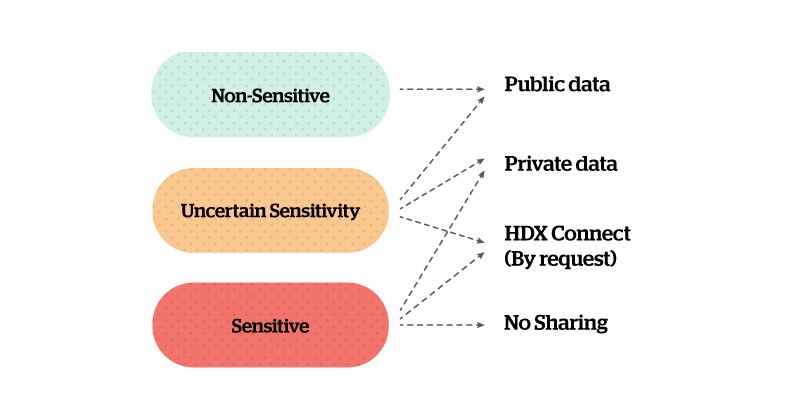Share
Since the launch of the Humanitarian Data Exchange (HDX) in 2014, over 290 organisations have shared more than 5,600 datasets through the platform. New ones are joining every week. We often get questions from HDX users about the various ways to share data through the platform and what data should be understood as sensitive. We hope this blog post answers some of those key questions.
HDX has always offered public and private data sharing. Public data cannot include personally identifiable information (PII), such as the identity of affected people. We do allow some personal information, such as the contact details of humanitarian workers, to be shared in private data. All of this is covered in our Terms of Service.
Over the years, there has been a shift from purely open data to more nuanced ways to share and protect data. In response, we recently released HDX Connect. This allows organisations to share the existence of data by publishing only the metadata and releasing the underlying data by request.
In summary, there are three ways to share data through HDX:
- Public – Data shared publicly is accessible to all users of the HDX platform, whether or not they are registered. All public data must be shared under an appropriate license (see all licence options here). Select the ‘public’ setting in the metadata field when uploading the data.
- Private – Organisations can share data privately with their members. The administrator of each organisation controls who can become a member. Select the ‘private’ setting in the metadata field when uploading the data.
- By Request – Organisations share the metadata of a dataset and grant access to the full data when requested by a registered user.
The decision on how to share data is based on positive (quick, open access) and negative (potential harm) consequences within a set of red lines formed by data subjects’ fundamental rights, including the right to privacy and other human rights enshrined in the Universal Declaration of Human Rights and treaty law. Data sensitivity refers to the likelihood of risks to crisis-affected populations or other stakeholders, materialising upon release of the data.
For the purpose of sharing data through HDX, we have developed the following categories to communicate data sensitivity:
1. Non-Sensitive The least sensitive category of data is considered ‘non-sensitive’ data. This category includes datasets containing country statistics, roadmaps, weather data and other data with no foreseeable risk associated with sharing.
|
|
2. Uncertain Sensitivity For this data, sensitivity depends on a number of factors, including other datasets collected in the same context, what technology is or could be used to extract insights, and the local context from which the data is collected or which will be impacted by use of the data.
|
|
3. Sensitive This includes any dataset containing personally identifiable information on affected populations or aid workers. Datasets containing demographically identifiable information (DII) or community identifiable information (CII) that can put affected populations or aid workers at risk, are also considered sensitive data. Depending on context, satellite imagery can also fall into this third category of sensitivity.
|
The decision to share and selecting the appropriate option for sharing will depend on a number of factors. However, a dataset containing sensitive data should be shared through HDX Connect, or publicly once sensitive data has been removed.
Below are possible scenarios for how to share data on HDX taking into account the level of sensitivity:

Examples:
| In preparation of the response to Hurricane Irma, infrastructure maps of various countries along the hurricane’s route were shared on HDX. These maps do not contain any PII or DII, and misuse of these maps to cause harm seems unlikely. Since the data was non-sensitive, it was the right decision to share publicly.
If similar infrastructure maps containing the locations of hospitals or other safety zones or neutral zones were produced in Syria, they would be more sensitive as they could expose aid workers to targeting. Depending on the granularity and other aspects of such a map, it would fall into the Sensitive or Medium-Sensitive range. |
OCHA’s Centre for Humanitarian Data in The Hague has been established to provide the humanitarian community with assistance on Data Services, Literacy, Policy and Network Engagement. For more information or for assistance with a particular decision on data sharing through HDX, send an email to centrehumdata@un.org or find us @humdata.